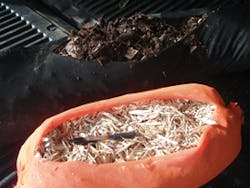Silt Fence Applications in Separating Contaminated Sediments
In Part 3 of this continuing series about sediment and erosion control, author Linda Robinson discusses the importance of preventing contaminated sediment from entering a Lake Michigan tributary with stormwater runoff. The silt fence and other sediment and erosion control devices showcase best management practices during major dredging operations of contaminated soil in an effort to improve the water quality of the Grand Calumet River.
Getting the Upper Hand on Sediment (Part 3) By Linda Robinson
Specialized products solve a range of construction site challenges.
The Legacy Act and the Grand Calumet River
A project under way on the Grand Calumet River is being partially financed with funds from the Great Lakes Legacy Act. The majority of the Grand Calumet River drains into Lake Michigan, with approximately a billion gallons a day making its way from the east end of Gary, IN. From there, it courses some 13 miles past the industrialized cities of Gary, East Chicago, and Hammond. Just south of downtown Chicago is the portion of the river referred to as the AOC, or area of concern. That’s because much of the river’s flow actually begins as municipal and industrial effluent, cooling and process water, and urban stormwater runoff. And although the discharges have lessened, contaminants still impair the AOC.
Efforts along the river include a 1.8-mile length to be restored between Indianapolis Boulevard and Hohman Avenue. Because most of the pollutants are tied up in the sediment that lies at the bottom of the Grand Calumet River, massive dredging operations are taking place. There are some 5 million to 10 million cubic yards of sediment contaminated with PCBs, PAHs, and heavy metals like mercury and lead, referred to as “legacy pollutants.”
“Because of the size of the site, there are multiple BMPs being used,” says Joe Moore, vice president with Moore & Moore Erosion Control & Siltworm in Crown Point, IN. “Most of our involvement was at the site in Gary, but we have our product at multiple locations. Our company supplied and installed Siltworm as a perimeter control at the very beginning of construction.”
Moore & Moore Erosion Control manufactures Siltworm, a very large perimeter control device similar to a long, absorbent snake. Although it looks like it can literally surround several blocks, Moore explains that 90% of the company’s orders are for 8-foot sections that can be installed at a site with about a 6-inch overlap connecting them. The Siltworm is 9 inches in diameter, and each section weighs approximately 80 pounds when saturated. Moore points out that the segments are filled at the manufacturing plant, to achieve consistent quality.
Getting the Upper Hand on Sediment (Part 3) By Linda Robinson
Specialized products solve a range of construction site challenges. The Legacy Act and the Grand Calumet River A project under way on the Grand Calumet River is being partially financed with funds from the Great Lakes Legacy Act. The majority of the Grand Calumet River drains into Lake Michigan, with approximately a billion gallons a day making its way from the east end of Gary, IN. From there, it courses some 13 miles past the industrialized cities of Gary, East Chicago, and Hammond. Just south of downtown Chicago is the portion of the river referred to as the AOC, or area of concern. That’s because much of the river’s flow actually begins as municipal and industrial effluent, cooling and process water, and urban stormwater runoff. And although the discharges have lessened, contaminants still impair the AOC. Efforts along the river include a 1.8-mile length to be restored between Indianapolis Boulevard and Hohman Avenue. Because most of the pollutants are tied up in the sediment that lies at the bottom of the Grand Calumet River, massive dredging operations are taking place. There are some 5 million to 10 million cubic yards of sediment contaminated with PCBs, PAHs, and heavy metals like mercury and lead, referred to as “legacy pollutants.” “Because of the size of the site, there are multiple BMPs being used,” says Joe Moore, vice president with Moore & Moore Erosion Control & Siltworm in Crown Point, IN. “Most of our involvement was at the site in Gary, but we have our product at multiple locations. Our company supplied and installed Siltworm as a perimeter control at the very beginning of construction.” Moore & Moore Erosion Control manufactures Siltworm, a very large perimeter control device similar to a long, absorbent snake. Although it looks like it can literally surround several blocks, Moore explains that 90% of the company’s orders are for 8-foot sections that can be installed at a site with about a 6-inch overlap connecting them. The Siltworm is 9 inches in diameter, and each section weighs approximately 80 pounds when saturated. Moore points out that the segments are filled at the manufacturing plant, to achieve consistent quality. [text_ad] In 1991, the Citizen’s Advisory for the Remediation of the Environment Committee (CARE) began working in an active role with the Department of Environmental Management (DEM) to help implement the Remedial Action Plan (RAP) and make future updates in the AOC. (That should provide anyone with his or her daily dose of acronyms.) It is estimated that 350,000 cubic yards of sediment will be dredged and capped. As one section is dredged and completed, another section will be dredged until the area is restored. In 2016, once dredging is complete, wetlands are slated to be restored and planted with native plants. “Siltworm is there for the duration of the project,” says Moore. “With its very low maintenance, availability to be placed in a wetland, and ability to separate contaminants from stormwater, it was a perfect fit. As a manufacturer and supplier of Siltworm, it was a great place to showcase our technology, which—being less than 10 years old—is often not known as an option to engineers who do design work. Our real work is educating engineers and municipalities.” Siltworm is filled with a proprietary blend of bark-free, kiln-dried hardwood mulch. The filler can act as compost. Because the mulch filler is kiln-dried, it acts as a sponge when it gets wet, providing filtration. As of last year, the Legacy Act project had removed 580,000 cubic yards of sediment in the second dredging on the West Branch of the Grand Calumet River. Cleanup efforts in the Roxana Marsh Branch of the river were completed in 2011 at a cost of $31.1 million, with 50,000 cubic yards of sediment dredged. Fish and other aquatic species have improved, and restrictions on drinking water were lifted after US Steel completed numerous projects that included removal of 800,000 cubic yards of sediment, thereby reducing harmful contaminants in the Grand Calumet River.In 1991, the Citizen’s Advisory for the Remediation of the Environment Committee (CARE) began working in an active role with the Department of Environmental Management (DEM) to help implement the Remedial Action Plan (RAP) and make future updates in the AOC. (That should provide anyone with his or her daily dose of acronyms.) It is estimated that 350,000 cubic yards of sediment will be dredged and capped. As one section is dredged and completed, another section will be dredged until the area is restored. In 2016, once dredging is complete, wetlands are slated to be restored and planted with native plants.
“Siltworm is there for the duration of the project,” says Moore. “With its very low maintenance, availability to be placed in a wetland, and ability to separate contaminants from stormwater, it was a perfect fit. As a manufacturer and supplier of Siltworm, it was a great place to showcase our technology, which—being less than 10 years old—is often not known as an option to engineers who do design work. Our real work is educating engineers and municipalities.”
Siltworm is filled with a proprietary blend of bark-free, kiln-dried hardwood mulch. The filler can act as compost. Because the mulch filler is kiln-dried, it acts as a sponge when it gets wet, providing filtration.
As of last year, the Legacy Act project had removed 580,000 cubic yards of sediment in the second dredging on the West Branch of the Grand Calumet River. Cleanup efforts in the Roxana Marsh Branch of the river were completed in 2011 at a cost of $31.1 million, with 50,000 cubic yards of sediment dredged. Fish and other aquatic species have improved, and restrictions on drinking water were lifted after US Steel completed numerous projects that included removal of 800,000 cubic yards of sediment, thereby reducing harmful contaminants in the Grand Calumet River.






